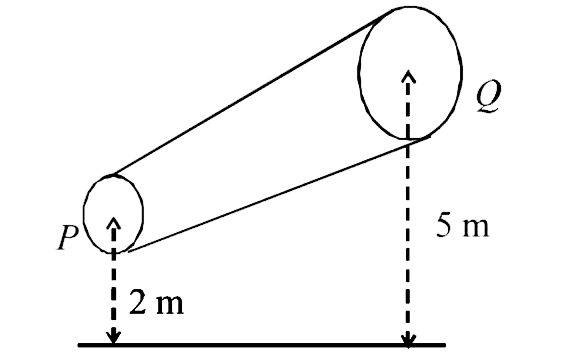As an air bubble rises from the bottom of a lake to the surface, its volume is doubled. Find the depth of the lake. Take atmospheric pressure = 76 cm of Hg.Solution in Gujrati
The correct Answer is:10,34m
Step by step video & image solution for As an air bubble rises from the bottom of a lake to the surface, its volume is doubled. Find the depth of the lake. Take atmospheric pressure = 76 cm of Hg. by Physics experts to help you in doubts & scoring excellent marks in Class 11 exams.
Updated on:21/07/2023Topper's Solved these Questions
- ELASTICITY, SURFACE TENSION AND FLUID MECHANICSBOOK - ALLEN CHAPTER - ELASTICITY, SURFACE TENSION AND FLUID MECHANICSEXERCISE - Exercise 4 A (Fuild Dynamics)
7 Videos
- ELASTICITY, SURFACE TENSION AND FLUID MECHANICSBOOK - ALLEN CHAPTER - ELASTICITY, SURFACE TENSION AND FLUID MECHANICSEXERCISE - Exercise 4 A (Viscosity)
3 Videos
- ELASTICITY, SURFACE TENSION AND FLUID MECHANICSBOOK - ALLEN CHAPTER - ELASTICITY, SURFACE TENSION AND FLUID MECHANICSEXERCISE - Exercise 4 A (Surface Tension)
5 Videos
- CENTRE OF MASSBOOK - ALLEN CHAPTER - CENTRE OF MASSEXERCISE - EXERCISE-V B
19 Videos
- ERROR AND MEASUREMENTBOOK - ALLEN CHAPTER - ERROR AND MEASUREMENTEXERCISE - Part-2(Exercise-2)(B)
22 Videos
Similar Questions
A non-viscous liquid of constant density 1000kg/m3 flows in a streamline motion along a tube of variable cross section. The tube is kept inclined in the vertical plane as shown in Figure. The area of cross section of the tube two point P and Q at heights of 2 metres and 5 metres are respectively 4×10−3m2 and 8×10−3m2. The velocity of the liquid at point P is 1m/s. Find the work done per unit volume by the pressure and the gravity forces as the fluid flows from point P to Q.

View SolutionA flask contains glycerine and the other contains water. Both are stirred vigorously and placed on the table. In which flask will the liquid come to rest earlier and why?
View Solution_E01_194_Q01.png)
PQRS is a rectangular frame of copper wire shown in figure the side RS of the frame is movable. If a soap film is formed on it then what is the diameter of the wire to maintain equilibirum (given surface tension of soap solution =0.045N/m and density of copper =8.96×103kg/m3)
View SolutionTwo particles of masses m1 and m2 in projectile motion have velocities →v1 and →v2 , respectively , at time t=0. They collide at time t0. Their velocities become →v'1 and →v'2 at time 2t0 while still moving in air. The value of ∣∣∣(m1→v'1+m2→v'2)−(m1→v1+m2→v2)∣∣∣
View SolutionA cube has a side of length 1.2×10−2m. Calculate its volume.
View SolutionAn air bubble starts rising from the bottom of a lake. Its diameter is 3.6mm at the bottom and 4mm at the surface. The depth of the lake is 250cm and the temperature at the surface is 40∘C. What is the temperature at the bottom of the lake? Given atmospheric pressure = 76cmofHgandg=980cm/s2.
View SolutionWhen a large bubble rises from the bottom of a lake to the surface its radius doubles. If atmospheric pressure is equal to that of column of water height H then the depth of lake is
View SolutionThe volume of an air bubble becomes three times as it rises from the bottom of a lake to its surface. Assuming atmospheric pressure to be 75 cm of Hg and the density of water to be 1//10 of the density of mercury, the depth of the lake is
View SolutionAn air bubble starts rising from the bottom of a lake. Its diameter is 3.6 mm at the bottom and 4mm at the surface. The depth of the lake is 250 cm and the temperature at the surface is 40^@C . The atmospheric pressure is 76 cm of Hg and g=980 cm.s^-2 . What is the pressure at the bottom of the lake?
View SolutionAn air bubble starts rising from the bottom of a lake. Its diameter is 3.6 mm at the bottom and 4mm at the surface. The depth of the lake is 250 cm and the temperature at the surface is 40^@C . The atmospheric pressure is 76 cm of Hg and g=980 cm.s^-2 . What is the temperature at the bottom of the lake?
View SolutionThe volume of an air bubble is doubled as it rises from the bottom of lake to its surface, The atmospheric pressure is 75 cm of mercury. The ratio of density of mercury to that of lake water is (40)/(30) , the depth of the lake in metre is
View SolutionAn air bubble doubles in radius on rising from the bottom of a lake to its surface. If the atmospheric pressure is equal to that of a column of water of height H, the depth of lake is
View SolutionWhen a large bubble rises from the bottom of a lake to the surface its radius doubles. If atmospheric pressure is equal to that of column of water height H then the depth of lake is
View Solutionएक वायु के बुलबुले के झील में पेंदे से सतह पर जाने पर आयतन दुगुना हो जाता है यदि झील के पानी का घनत्व पारे के घनत्व 1/n गुना है तथा वायुमण्डलीय दाब H ऊँचाई की Hg के बराबर है तो झील की गहराई ज्ञात करो।
View SolutionAn air bubble starts rising from the bottom of a lake. Its diameter is 3.6mm at the bottom and 4mm at the surface. The depth of the lake is 250cm and the temperature at the surface is 40∘C. What is the temperature at the bottom of the lake? Given atmospheric pressure = 76cmofHgandg=980cm/s2.
View SolutionThe volume of an air bubble becomes three times as it rises from the bottom of a lake to its surface. Assuming atmospheric pressure to be 75 cm of Hg and the density of water to be 1//10 of the density of mercury, the depth of the lake is
View Solution
